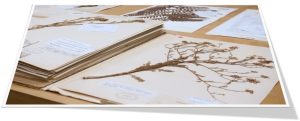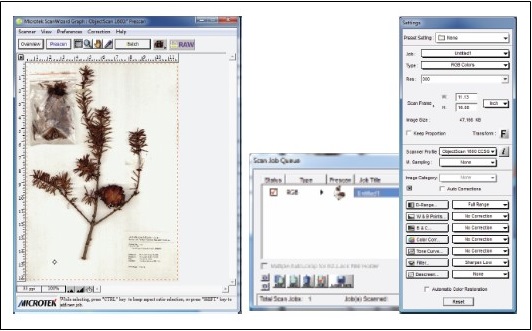Introduction to Herbarium Specimen Digitization

Examples of Dried and Mounted plant samples that are generally referred to as Herbarium Specimens
Traditionally, Herbarium Specimen Digitization or ‘herbarium’ referred to books about medicinal plants. The term, originating from the Latin word ‘herba’, meaning ‘green crops’, served to highlight mankind’s early fascination with plant-based remedies.
However, the scope of the term underwent a significant change in the 1700s when French botanist Joseph Pitton de Tournefort utilized ‘herbarium’ to describe a collection of preserved plants. This marked a broadening of its use, a shift from the medicinal focus to a more encompassing representation of the plant world.
This shift by Tournefort essentially sowed the seeds for what we now recognize as Herbarium Specimen Digitization, a field that marries the study of botany with advancements in technology. This integration has revolutionized botanical research, making the study of plant species more accessible and comprehensive than ever before.
The Importance of Digitizing Herbarium Specimens
Herbarium specimen digitization involves capturing data and images and storing them in digital format. This process enhances the accessibility of collections. Researchers can access these digital repositories anytime, anywhere, minimizing logistical hindrances. As a result, herbarium specimen digitization has become an essential tool in modern botanical research. Digitization, by converting physical specimens into digital assets, facilitates querying and analyzing collections. Botanists can sift through vast digital herbaria using keyword searches, simplifying data extraction. Moreover, digital images can be magnified, revealing minute details often invisible to the naked eye. Thus, digitization augments the analytical capabilities of researchers, fostering deeper insights.
Moreover, digitization democratizes access to herbarium collections. Previously, accessibility was limited by physical constraints such as location and preservation considerations. Now, anyone with an internet connection can access these treasures of botanical knowledge. This opens doors for amateur botanists, educators, and anyone with a keen interest in the plant kingdom.

Herbarium collection of plant samples preserved for long-term study, usually in the form of dried and pressed plants mounted on paper.
The Advantages of Herbarium Specimen Digitization
Herbarium collections harbor vast amounts of information pivotal for research, education, and conservation. Digitization optimizes the utilization of these resources, bringing a myriad of benefits. For instance, digitization enhances data integration across herbaria. Researchers can aggregate data from various collections, enabling comparative studies across geographical and temporal scales.
The digitization process also aids in tracking specimens. By tagging each digital image with metadata, researchers can easily track a specimen’s provenance and the history of its study. This metadata often includes the plant’s scientific name, collection date, location, and the collector’s name. Consequently, digitization aids in inventory management, an often challenging task given the enormous size of herbarium collections.
Furthermore, digitization facilitates virtual access to collections. Those unable to visit physical collections due to geographical constraints or lack of resources can still explore these treasures. Virtual access also eliminates the risk of damaging delicate specimens, safeguarding these valuable resources for future generations.
Steps in Herbarium Specimen Digitization
The process of herbarium specimen digitization consists of three strategic steps. The first step entails strategic analysis and setting targets. Senior and middle management collaborate to envision a digital agenda, identifying key objectives and performance indicators. This stage lays the groundwork, providing a road-map for the digitization process.

A Total Solution For Herbarium Specimen Digitization and Archive Management
The second step involves setting up the operational digitization strategy. This includes selecting appropriate technology, designing workflows, and training staff. Given the delicate nature of herbarium specimens, care must be taken to choose non-destructive digitization methods. Moreover, workflow design should maximize efficiency while ensuring the preservation of specimen integrity.
The final step is implementing the digitization strategy. Execution involves capturing high-resolution images of specimens and accompanying labels. Each image is then linked with metadata, ensuring easy retriev-ability. Regular monitoring and evaluation ensure the process aligns with the set objectives, ensuring continual improvement.
Microtek ObjectScan 1600: A Game-Changer in Digitization
The Microtek ObjectScan 1600 has been a revolutionary addition to herbarium specimen digitization. Specifically designed for digitizing herbarium specimens, this scanner captures high-resolution images while ensuring the preservation of specimen integrity. With a maximum resolution of 1600 dpi, it guarantees detailed, precise images, making it an indispensable tool for botanists.
The ObjectScan 1600 comes bundled with ScanWizard Graphy. This software provides scanner settings and image correction tools, enhancing the quality of digitized images. It also includes an OCR (Optical Character Recognition) function that can automatically detect and read label and barcode information on botanical collections.
The Microtek ObjectScan 1600 isn’t just a scanner; it’s a comprehensive digitization solution. Along with the ScanWizard Botany, it includes MiVAPP Botany, a botanical database management system. This system allows botanical gardens, universities, and museums to share their collections online, extending the reach of herbarium collections.
Unique Features of ObjectScan 1600
The ObjectScan 1600 stands out in the digitization sphere due to its unique features. It adopts an on-top scan design that protects fragile plant specimens. This design prevents damage that can occur with traditional upside-down scanning methods, ensuring the preservation of specimen morphology.
The scanner boasts a high-resolution color CCD with a resolution of up to 1600 pixels per inch. This feature, coupled with a built-in 48-bit ADC (Analog to Digital Converter), ensures the accurate capture of specimen details. Thus, even surface textures can be precisely presented in a high-fidelity format.
Additionally, the ObjectScan 1600 has a Depth of Field of up to +/- 6.5 mm at 300 dpi. This feature accommodates uneven or protruding parts of plant specimens, crucial for specimens with corns and fruits. This feature enables the preservation and presentation of the original characters of specimens for academic purposes.
Automated Metadata Recognition with ScanWizard Botany

Captured Specimen with label information such as title, code and serial number
ScanWizard Botany takes the hassle out of data entry. This software recognizes specimen label information and automatically saves it as metadata. Information is titled by herbarium code and specimen serial number in XML format, simplifying data retrieval. Moreover, various image adjustment options like contrast, lightness, and sharpness are available, enabling curators to enhance image quality.
The software is equipped with OCR (Optical Character Recognition), a vital tool in digitization. OCR can read text on specimen labels, converting it into digital text. This feature eliminates the need for manual data entry, a time-consuming and error-prone process. Moreover, it enhances the accessibility of label information, as digital text can be queried using keyword searches.
The digitization process isn’t just about creating a digital replica of a specimen. It’s about transforming physical specimens into searchable data. Through automated metadata recognition, ScanWizard Botany takes us closer to this goal. By simplifying the digitization process, it enables researchers to focus on what they do best: unraveling the secrets of the plant kingdom.
Image Archive and Account Management with MiBotany
MiBotany is a web-server system and specimen image authentication database. It’s an efficient, integrated multi-functional platform that allows for image quality validation and metadata profile validation. After validation from professionals, MiBotany updates the system, making verified specimens accessible to the public.
One of the key features of MiBotany is its hierarchical login-based system. This system ensures the integrity of the digitized collections by allowing only authorized individuals to modify data. Moreover, the system maintains a log of changes, enabling accountability and transparency.
MiBotany isn’t just a database; it’s a community. It bridges the gap between botanical gardens, universities, museums, and the public, fostering the exchange of knowledge. By ensuring the authenticity of digitized specimens, MiBotany plays a vital role in preserving the integrity of digital herbaria.
Conclusion: The Future of Herbarium Specimen Digitization
Indeed, herbarium specimen digitization stands as the frontier of botanical research. Unquestionably, it democratizes access to botanical treasures, fosters data integration, and significantly enhances the analytical capabilities of researchers. Additionally, digitization serves to safeguard these invaluable resources, assuring their availability for future generations.
Particularly, tools like the Microtek ObjectScan 1600 have been instrumental in propelling herbarium specimen digitization forward. Not only do they ensure the preservation of specimen integrity, but they also capture high-resolution images and automate data capture. Consequently, these tools have completely transformed digitization workflows, effectively paving the way for a new era in botanical research.
In light of the rapid biodiversity loss, the importance of herbarium specimen digitization becomes more pronounced. Specifically, it provides a snapshot of plant diversity across time, thereby offering valuable insights into plant evolution and adaptation. Coupled with continuous technological advancements, we can eagerly anticipate a future where every herbarium specimen is just a click away
Contact ABTec Solutions today on Toll Free (800) 775.8993 or reach out and fill the form and we will contact you as soon as possible.



